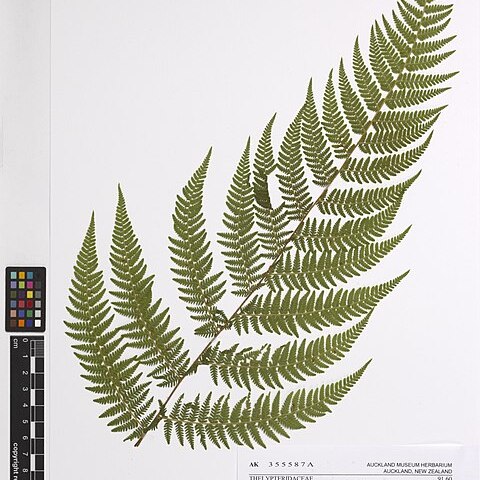Rhizome short-creeping with ascending apex, scaly; scales brown, to c. 20 mm long, to 1 mm wide, thickened near the base, clothed with acicular and capitate hairs. Frond 60–150 cm long, herbaceous, dull green, becoming yellowed in exposed situations. Stipe to 80 cm long, pale brown, not glaucous, bearing abundant pale yellow capitate hairs, and clothed, especially in lower half, with slender whitish hairs and pale brown scales; scales similar to those on the rhizome; scale bases persistent as warty protuberances. Lamina deeply 2-pinnate-pinnatifid, ovate to narrowly ovate, to 80 cm long, 70 cm wide; basal pinnae the largest, c. 10–35 cm long and 2–15 cm wide; largest secondary pinnae to 10 cm long, 2.5 cm wide, with tertiary pinnae connected by a very narrow wing along costa; upper surface of lamina between the veins glabrous; lower surface with short capitate hairs; both surfaces of rachis, costae and costules with acicular hairs as on stipe; lower surfaces bearing scattered whitish to pale brown narrow ciliate basally thickened scales to 3 mm long, grading distally to septate hairs; veins free, simple or forked. Sori small, on acroscopic branch of a vein; indusium small, rounded-reniform, persistent, bearing many short capitate hairs; sporangia with 1–3 capitate hairs near the annulus.
Caudex short, prostrate; stipe to 80 cm long, pale, basal half at least bearing copious acicular and capitate hairs and scales; scales thin, pale, to 20 mm long, hardly 1 mm wide at thickened base, bearing acicular hairs on surface near base, distally on edges, old stipe covered with wart-like bases of fallen scales. Lamina to 80 cm long; lower pinnae to 35 x 15 cm, rest gradually smaller; lower surface of rachis (sparsely) and pinna-rachis (copiously) bearing narrow pale scales to 3 mm long, 0.3 mm wide with thickened bases and slender patent marginal hairs; largest pinnules 10 x 2.5 cm, almost at right angles to pinna-rachis, with tertiary leaflets connected by a very narrow wing on costa; upper surface of costa densely hairy, of costules sparsely, very narrow hair-pointed and eiliate scales on lower surface of costa grading distally to slender septate hairs; tertiary leaflets at right angles to costa, larger ones deeply lobed, capitate hairs on lower surface. Sori small, on acroscopic branch of a vein; indusia small, with capitate hairs; sporangia with capitate hairs.

